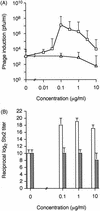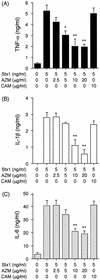Effects of azithromycin on shiga toxin production by Escherichia coli and subsequent host inflammatory response
- PMID: 12384353
- PMCID: PMC128727
- DOI: 10.1128/AAC.46.11.3478-3483.2002
Effects of azithromycin on shiga toxin production by Escherichia coli and subsequent host inflammatory response
Abstract
Shiga toxin (Stx)-producing Escherichia coli (STEC) colonizes the human intestinal mucosa, produces Stx from phage, and causes the development of hemolytic-uremic syndrome via Stx-induced inflammatory cytokine production. Azithromycin exhibited strong in vitro activity against STEC without inducing Stx-converting phage, in marked contrast to norfloxacin. Azithromycin decreased the tumor necrosis factor alpha (TNF-alpha), interleukin-1beta (IL-1beta), and IL-6 production from Stx-treated human peripheral mononuclear cells or monocytes to a greater extent than did clarithromycin. In Stx-injected mice, azithromycin significantly suppressed Stx-induced TNF-alpha, IL-1beta, and IL-6 levels in serum and improved the outcome as assessed by survival rate. In the STEC oral infection experiment using immature mice immediately after weaning (weaned immature-mouse model), all mice died within 7 days postinfection. Azithromycin administration gave the mice 100% protection from killing, while ciprofloxacin administration gave them 67% protection. The data suggest that azithromycin (at least at higher concentrations) has a strong effect on Stx production by STEC and on the Stx-induced inflammatory host response and prevents death in mice. Azithromycin may have a beneficial effect on STEC-associated disease.
Figures





References
-
- American Gastroenterological Association. 1995. Consensus conference statement: Escherichia coli O157:H7 infections—an emerging national health crisis, July 11-13, 1994. Gastroenterology 108:1923-1934. - PubMed
-
- Cyong, J., K. Kodama, A. Yafune, M. Takebe, and H. Takayanagi. 1995. Phase I study of azithromycin—single dose and multiple dose for 3 days. Jpn. J. Chemother. 43(Suppl. 6):139-163.
-
- Fong, J. S., J. P. de Chadarevian, and B. S. Kaplan. 1982. Hemolytic-uremic syndrome. Current concepts and management. Pediatr. Clin. North Am. 29:835-856. - PubMed
-
- Food Sanitation Division Environmental Health Bureau Ministry of Health and Welfare, Japan. 1997. Report on enterohemorrhagic Escherichia coli O157 infections. Ministry of Health and Welfare, Tokyo, Japan.
Publication types
MeSH terms
Substances
LinkOut - more resources
Full Text Sources
Medical

